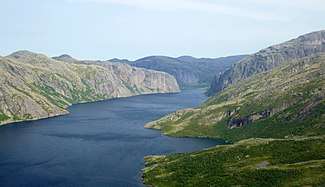Mealy Mountains National Park
Akami-Uapishkᵁ-KakKasuak-Mealy Mountains National Park Reserve is a national park reserve in central Labrador, Canada. This 10,700 km2 national park was established 2015 to protect boreal forest, caribou, Atlantic salmon and trout, wolves, black bear, marten and fox, mountains, tundra, fjords and expansive native landscapes.
Understand
The glacially-rounded, bare rock summits of the Mealy Mountains reach up to 1180 meters to overlook Lake Melville.

The park covers 10,700 km² (4,131 sq mi), an area a bit larger than that of Lebanon.
Along with the Mealy Mountains, the proposed park will protect a large portion of boreal forest, tundra and 50 km of shoreline on the Labrador Sea. Once established, it will be the largest national park in eastern Canada.
A National Park Reserve is an area that has been set aside with the intention of becoming a national park, pending the settlement of native land claims. Until then, they are managed as national parks under the National Parks Act.
The park was announced in 2010 by the federal government. At the same time, the government of Newfoundland and Labrador announced that a proposed Provincial Waterway Park would also be created. It will be adjacent to Mealy Mountains and will protect the Eagle River watershed. Together, the two parks will protect approximately 13,000 km² (5,019 sq mi). The park will be unique because it will allow for traditional Aboriginal activities not permitted in most other parks, such as hunting, trapping, fishing and cutting wood for personal use. However, further development of the land and mining will not be allowed.
- Park reserve office, ☎ +1 709 896-2394, e-mail: mealymountains.gmp@pc.gc.ca.
History
For thousands of years, ancient human cultures have also called this place home. For the Innu, Inuit, and others, the landscapes of this outstanding natural region hold great cultural significance. The traditional names of the park are Akami-uapishku, an Innu word meaning White Mountains across, and KakKasuak, a Labrador Inuit word for mountain.
Landscape
The landscape of mountain tundra, marine coasts, boreal forests, islands and rivers is home to many boreal species.
Flora and fauna
It is inhabited by a variety of wildlife, including the threatened Mealy Mountains woodland caribou herd. Other mammals that inhabit this park reserve are wolf packs, black bear, marten and two species of fox. An agreement with the native peoples of the area, including the Inuit, Innu and NunatuKavut will allow them to continue to hunt, trap and fish in the protected area.
Climate
Get in
Mealy Mountains is off the grid; there are no roads. Access is by boat from Cartwright (pop. 1000) or from Rigolet (pop. 269), the most southerly Inuit community in the world. The lone outfitter in Cartwright (Experience Labrador tours) is able to transport tour groups to the park and the Wundarstrand beach – presumably by sea.
Charter flights are available from Happy Valley-Goose Bay, the nearest city, on helicopters or float planes. Outfitters may package transportation with tours or lodging near the park.
Fees and permits
Parks Canada Passes
The Discovery Pass provides unlimited admission for a full year at over 80 Parks Canada places that typically charge a daily entrance fee It provides faster entry and is valid for 12 months from date of purchase. Prices for 2018 (taxes included):
- Family/group (up to 7 people in a vehicle): $136.40
- Children and youth (0-17): free
- Adult (18-64): $67.70
- Senior (65+): $57.90
The Cultural Access Pass: people who have received their Canadian citizenship in the past year can qualify for free entry to some sites.
Get around
See
Do
- A 50 km stretch of sandy beaches at the edge of the park, known since Viking times as the Wunderstrand, is suitable for hiking.
Buy
Eat
Drink
Sleep
Lodging
- Park Lake Lodge, ☎ +1 709 899-1992, fax: +1 709 896-9551. Outfitter with lodging on Park Lake, west of the park. The return trip from Goose Bay by fixed-wing aircraft, with 3-7 days of lodging, runs $3000-5000/person.
Camping
- Experience Labrador Tours, 20 Lethbridge Lane, Cartwright (Labrador), ☎ +1 709 938-7444. Various tours and outdoor expeditions, either returning to Cartwright same-day or tent camping overnight. Seasonal.
Backcountry
Stay safe
Mealy Mountains National Park Reserve is on native land; Innu and Inuit natives do still live and hunt here.
The park is remote and infrastructure non-existent. All of the usual warnings about dangerous animals and safety in the wilderness apply. Labrador's climate is sub-Arctic and harsh; in an emergency, help is not close at hand – the closest hospital is in Goose Bay and, if the weather is stormy, it is possible to be stranded with no way in or out for days.
Connect
The only easy way to receive voice or data messages in the wilderness of Labrador is by satellite. There is no commercial electric power, no landline telephone and no mobile base station in the park.